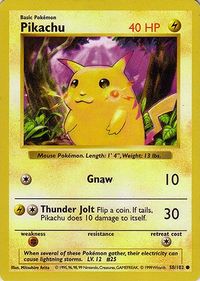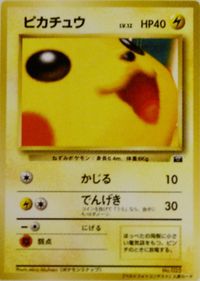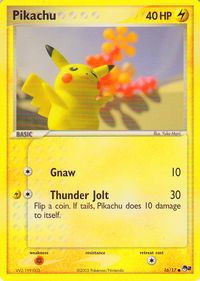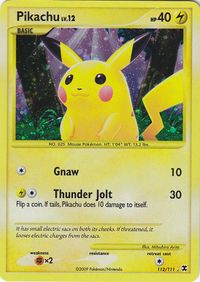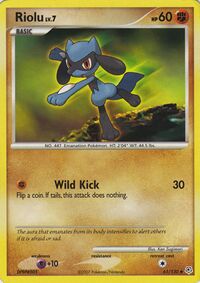This card was included in the Base Set with artwork by Mitsuhiro Arita, first released in the Japanese Expansion Pack. It has two versions: a red-cheeked variant and the true yellow-cheeked version. The red-cheeked variant is a highly sought-after experimental print from 1st Edition and early Unlimited print runs. Both versions also have promotional variants with a gold foil "E3" stamp where the set symbol would appear in later sets. The yellow-cheeked version was available as an insert in the September 1999 issue of Nintendo Power, while the red-cheeked variant was distributed to those who visited the Nintendo booth at the Electronic Entertainment Expo (E3) between May 13-15, 1999. Similarly to the non-promotional versions, the red-cheeked variant is considerably more valuable. In Japan, this card was reprinted with artwork by Mina Akuhara, one of five winning entries of the CoroCoro Pokémon Snap Best Photo Contest held in Spring 1999. This print has a camera graphic where an expansion symbol normally would be and text on the bottom right reads: Best Photo Contest Winners Prize Card. This version is extremely rare and the exact number in existence is unknown. The Base Set yellow-cheeked version was released again as a promotional card in Japan, but in English on Japanese card stock as part of the Pokémon Song Best Collection CD. The yellow-cheeked version of the Base Set print also has another promotional variant with a gold foil "PokéTour 1999" stamp in the top right corner of the illustration. This card was included in 'Tour packs' distributed at locations visited by the PokéTour in Australia in 1999, which were advertised to be limited to 3000 at each venue. The PokéTour consisted of two separate tours: Red, which ran on weekends from September 18 to October 9, 1999; and Blue, which ran on weekends from September 18 to October 7, 1999. A Jumbo version of the Base Set print was included with the February 2000 issue of Top Deck Magazine. The yellow-cheeked version of the Base Set print was reprinted in the Bulbasaur Deck of the Japanese Intro Pack, in the Base Set 2 expansion, and in the Totodile Half Deck of the Japanese Intro Pack Neo.
This card was later reprinted in the POP Series 2 with new artwork by Yuka Morii, first released as one of the Japanese PCG-P Promotional cards, made available as part of a Meiji Chocolate campaign in June 2005. A special reprint was included in the Rising Rivals expansion with redrawn art by Mitsuhiro Arita, first released in the Japanese Bonds to the End of Time expansion.
Gallery
|
|
|
|
Altered Base Set print, featuring
Pikachu with red cheeks
|
|
|
|
|
|
|
|
|
|
|
|
|
|
|
|
|
|
|
|
|
|
|



